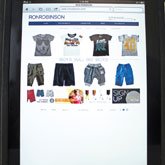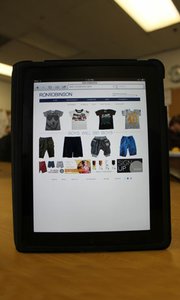Retailers Embrace Tablet Commerce
With mobile commerce on the rise, tablet computers have given retailers new hope in boosting sales.
Shoppers are using mobile devices more frequently, and companies from Macy’s to PacSun, are experimenting with ways to entice mobile shoppers to use tablets in stores to increase sales.
More than 13 percent of online sales for the first quarter of 2012 came from mobile devices—an increase of more than 6 percent over the first quarter of 2011—according to IBM’s new economic indicator, which tracks online retail sales and consumer sentiment via social media.
The holiday season saw big increases in mobile traffic, and that strong momentum has continued into 2012, according to Jay Henderson, strategy director for IBM Digital Marketing. “It’s exciting to see that this trend is here to stay and that what we saw during the holidays wasn’t a seasonal anomaly but part of a regular pattern.”
Apple’s iPads saw more than 5 percent of online shopping traffic for the first quarter of 2012. “From a trending perspective, tablets are trending up and trending faster than other mobile devices,” he said.
Companies such as PacSun have armed their staff with iPads to share information on merchandise and place online orders for customers, and Fred Segal’s Ron Robinson store allows customers and personal shoppers to use them for photos or “live shopping” with permission from the store.
“It’s an interesting sales tool for brands and customers,” said Karen Meena, Ron Robinson’s vice president of buying and merchandising. “It’s more interactive and adds more to being in a store and highlighting new products.”
Vendors also use them for trunk shows to showcase their new lines. “They’ll have an iPad on the table with new products and more info on the line, company bios, and models wearing some of the clothing,” Meena said. “It’s a good way that customers can see the merchandise and items they can special order.”
Los Angeles–based Sol Angeles is one of the brands that uses a tablet to show customers its T-shirts and knitwear in different colors and styles. “People like it,” Meena said. “They interact with it. It’s really easy. It’s a good selling tool, and everyone knows how to use it.”
Buyers also use tablets to show Meena new lines instead of using line sheets.
“In my world, it has made things easier and more interesting. You can scan through and look at the looks they have, and it helps to see it through that perspective,” she said. “If I don’t have time to see the line and they have the picture and have some fabric swatches, you can see it in the store really quickly, and it’s really easy and immediate.”
Last fall, Macy’s and Bloomingdale’s began using tablets in 350 stores to help customers research skin-care products at their Clinique counters, as well as in shoe departments in select Bloomingdale’s stores, to help customers shop from an expanded selection of styles and colors. Both Macy’s and Bloomingdale’s have also installed free Wi-Fi service in multiple stores to allow smartphone and tablet shopping.
During the week preceding Valentine’s Day, 14.5 percent of all shoppers used mobile devices, with more than 24 percent of intimate-apparel sales coming from mobile gadgets. With the launch of Apple’s new iPad 3 in March, shoppers using iPads showed an increase of nearly 2 percent over the previous week, according to IBM’s retail data.
“We are definitely entering into the ‘post-PC’ era, where consumers are no longer shackled to their desktop computers,” IBM’s Henderson said.
Not only are tablet shoppers increasing, but they convert at more than twice the rate of any other mobile device, explained John Squire, IBM’s former director of digital marketing and analytics. This means they place items in their online shopping carts more often than other mobile shoppers. They also purchase the items placed in their carts more frequently.
Retailers have taken notice of tablet growth and are creating tablet-specific websites that focus more on swiping and scrolling instead of clicking with a mouse or typing on a small phone.
“The experience designing for a tablet is quite different than for a phone,” Henderson said. “Where phones have a heavy emphasis on location-based marketing and slim design, with tablets you need to cater to a richer user experience.”
Ron Robinson recently changed its homepage to a scrolling screen to better adapt to tablets and took away Adobe Flash from the site so that it is able to be downloaded to phones and iPads, Meena said.
Puma recently embraced a major digital overhaul of its Web and mobile sites in order to present customers with a better experience.
“The mobile site was a preliminary design focused purely on basic functionality and testing major Puma.com conversions, from time-saving (shopping and store finding) to time-wasting (reading news and watching videos),” said Jay Basnight, Puma’s head of digital strategy. “As more data is collected—and every month more traffic seems to hit the mobile site—the design will be re-evaluated. But right now we are seeing a lot of shopping and store finding.”
Puma’s desktop site was designed to function on a tablet, but the company is interested in brainstorming tablet-specific designs, as well.
“When we look at mobile traffic year over year and the continued adoption of mobile—for a number of years we’ve been talking about mobile being on its way or gaining momentum—and what we see now is that it’s here to say,” Henderson said. “The development of mobile tablets is an interesting subplot. … The online traffic from them has pretty profound implications for retailers.”
























